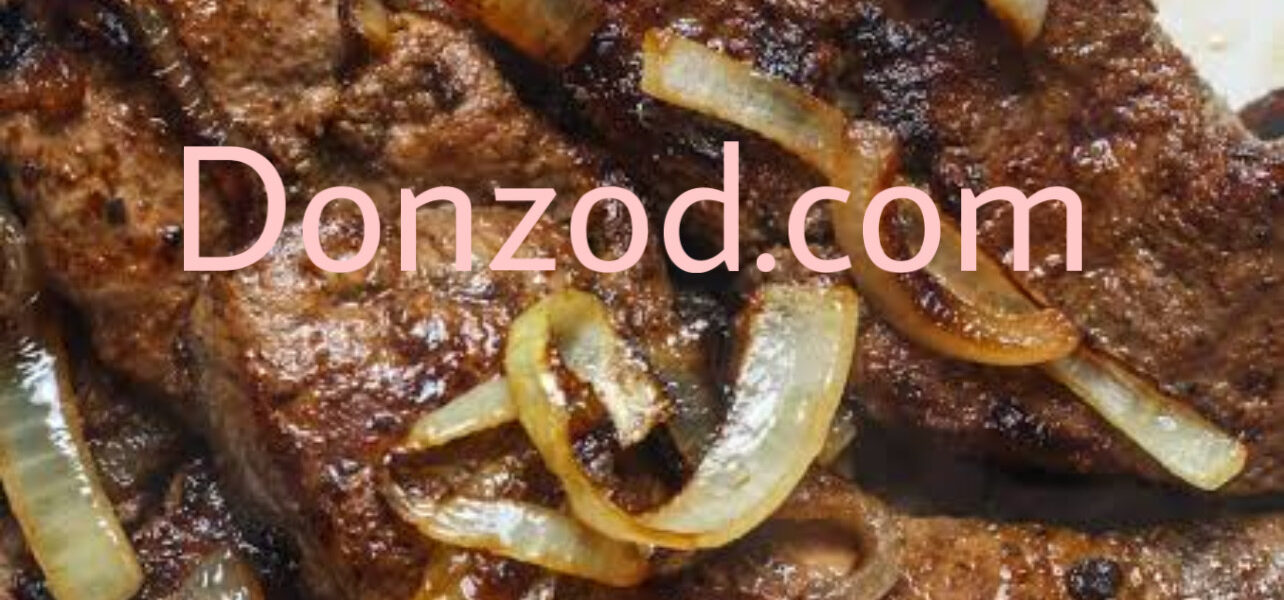Beef Liver has shown remarkable changes over time. Many of us may remember a time when the idea of consuming beef liver caused hesitation or complete rejection.
It was often associated with strong odor, an unusual texture, and the kind of meal that was tolerated more than enjoyed.
However, with a deeper understanding of nutrition and a renewed interest in traditional foods, beef liver has steadily found its way back into kitchens and mine included.
This article offers more than just a step-by-step recipe; it aims to highlight the value of beef liver as an accessible, affordable, and nutritious ingredient.
Whether you approach it for the first time or revisiting it after years of avoidance, I encourage you to consider this recipe and has earned a permanent place in my personal culinary collection.
The Nutritional Value of Beef Liver
Before addressing the method of preparation, it is worth examining why one should consider cooking beef liver in the first place.
Often overlooked in favor of more popular cuts of meat, liver is among the most nutrient dense foods available.
It contains high levels of iron, vitamin A, B12, folate, and other essential nutrients.
These components make it an excellent choice for individuals seeking to improve their dietary intake naturally and affordably.
Additionally, beef liver is economically friendly. It can often be purchased at a fraction of the cost of other meats, making it an attractive option for households attempting to balance nutrition with cost.
While it does possess a distinct flavor, proper preparation can transform it into a satisfying and enjoyable meal.
Understanding the Flavor of Beef liver
Beef liver possesses a bold, earthy flavor, sometimes described as metallic due to its high iron content.
This characteristic taste can be off-putting to some, but with the right seasoning and method, it can be transformed into a flavorful and memorable dish.
The recipe presented here is titled “Pan-Seared Beef Liver with Garlic, Onions, and a Hint of Citrus.”
It involves straightforward ingredients and cooking techniques that bring out the best in the liver while tempering its stronger qualities.
Ingredients:
- 1 pound of beef liver (preferably sliced thinly),
- 2 medium-sized onions, sliced into rings,
- 4 cloves of garlic, finely chopped,
- Juice from half a lemon (or vinegar, if lemon is unavailable),
- 1 teaspoon of ground black pepper,
- ½ teaspoon of smoked paprika (optional),
- 1 teaspoon of salt (adjust according to preference),
- ¼ teaspoon of dried or fresh thyme, ¼ cup of all-purpose flour,
- 2 to 3 tablespoons of cooking oil (vegetable, sunflower, or butter), Fresh parsley for garnishing (optional)
Preparation Methods of Beef Liver.
- Step 1: Soak the Liver. This preliminary step is essential. Liver can possess a strong, iron-heavy flavor that may be off-putting if not managed.
- Soaking it in an acidic liquid such as lemon juice, vinegar, or milk for 30 to 40 minutes helps reduce this intensity and also softens the texture.
- Simply place the sliced liver in a bowl and pour the lemon juice over it, diluted slightly with water if necessary.
- Step 2: Prepare the Onions. While the liver is soaking, slice the onions into rings.
- Using thicker slices allows the onions to retain their form during cooking and enhances their ability to caramelize properly.
- This step contributes significantly to the final flavor of the dish.
- Step 3: Dry and Season the Liver. Once soaking is complete, remove the liver from the liquid and pat it dry with a clean paper towel.
- This is crucial, as moisture can cause excessive splattering when the liver is placed in hot oil.
- Lightly coat the liver slices in a flour mixture seasoned with salt, pepper, and paprika.
- This coating adds a pleasant texture to the finished dish and prevents the liver from becoming rubbery.
- Step 4: Cook the Liver. Heat the cooking oil in a large skillet over medium heat. Once hot, add the liver slices in a single layer.
- Avoid overcrowding the pan, as this can cause steaming rather than searing.
- Cook each side for approximately 2 to 3 minutes. Liver cooks very quickly and becomes tough when overcooked, so it is important to monitor closely.
- When you cook the slices through and slightly brown them, remove them from the pan and keep them warm.
- Step 5: Prepare the Onion and Garlic Mixture. In the same pan, add the sliced onions and sauté over medium heat until they become soft and begin to caramelize.
- Add a small pinch of salt to aid in the process. Once the onions have reached a golden hue, add the garlic and thyme.
- An effective technique to brighten the flavors is to squeeze a small amount of lemon juice (or vinegar) over the onions near the end of cooking.
- This enhances the flavor of the dish and balances the richness of the liver.
- Step 6: Combine and Serve. Return the cooked liver to the pan and gently mix it with the onion and garlic mixture.
- Allow it to cook together for one additional minute so the flavors can meld, then remove from heat.
- Garnish with fresh parsley if available. This not only adds visual appeal but also provides a refreshing contrast to the richness of the dish.
Recommended side dish
This dish pairs excellently with mashed potatoes, white rice, steamed vegetables, or fried plantains.
A slice of rustic bread may also complement it well, especially when used to soak up the onion-infused oil.
It is advisable to include a component with some acidity such as a salad with vinaigrette to balance the meal and enhance digestibility.
Common Mistakes and How to Avoid Them
- Overcooking the Liver: Liver becomes tough and grainy when cooked for too long. It should be seared quickly and removed from heat once the center is just done.
- Skipping the Soaking Process: Failing to soak the liver can result in an overwhelming iron taste. This simple step greatly improves the final flavor.
- Overcomplicating the Seasoning: Because the liver has a naturally robust flavor, it is best complemented with simple seasonings rather than complex spice blends.
- Insufficiently Cooked Onions: The onions should be soft and golden. When undercooked, they fail to add the intended sweetness and depth to the dish.
Conclusion
Beef liver may not be the most fashionable ingredient in today’s culinary scene, but it is undoubtedly among the most beneficial and undervalued.
For those willing to invest a bit of time and care, it offers both nutrition and taste in abundance. Moreover, its affordability makes it accessible to households of all income levels.
Returning to traditional ingredients such as liver can serve as a reminder of simpler times when meals were prepared thoughtfully and ingredients were used respectfully.
This recipe, inspired by generations past, is one small way of preserving that legacy. Should you decide to prepare it, I hope the experience is both nourishing and enlightening. And if it becomes a new favorite, perhaps it is a sign that some of the old ways were worth holding onto after all.




